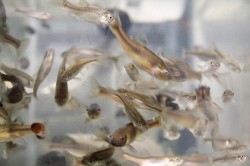The Hunt for Endocrine Disruptors
Study of Minnesota's lakes finds chemical levels that are likely to be found in Wisconsin.
Hormones and other chemicals
The researchers found other hormones, too —†progesterone, testosterone, and others. Most are produced naturally, by wildlife and people. One lake contained the synthetic hormone mestranol.
Common chemicals included nonylphenol, a breakdown product from detergents, agricultural and indoor pesticides, and cosmetics in 10 percent of the lakes. It acts like estrogen on lab animals, is “extremely toxic to aquatic organisms,” and has been found everywhere from groundwater to breast milk, according to the EPA.

Researcher Mark Ferrey, at a Minnesota Pollution Control Agency warehouse in St. Paul, with a brown glass bottle used for lake samples. Ferrey has found a variety of chemicals in nearly all the lakes he has tested. Kate Golden/Wisconsin Center for Investigative Journalism
They found triclosan, an antibacterial chemical found in hand soaps, toothpastes and toys, in 14 percent of the lakes. It has disrupted estrogen metabolism and thyroid function in rats, can break down into dioxins in surface water, is in three-quarters of U.S. urine samples, and was deemed toxic to the environment by Canada last year.
BPA, found in 43 percent of the lakes, is “a reproductive, developmental and systemic toxicant in animal studies,” according to the EPA. It is being studied as a possible cause of early puberty in children.
BPA, hormones and nonylphenol were found “at concentrations that have been shown to impair endocrine function in fish and wildlife,” the researchers wrote.
Risks are unclear
Just because there are chemicals in the water does not mean they are hurting people or wildlife, including fish populations.
“It’s one thing to say it has an effect on an organism, quite another to say it’s having an effect on the entire ecosystem,” Ferrey said.
Endocrine disruption may not always mean doom. In one Minnesota study, St. Cloud State University researcher Heiko Schoenfuss found that although Mississippi River walleye showed evidence of endocrine disruption, the population seemed healthy.
Yet signs are emerging that populations may be affected: Schoenfuss found that minnows exposed to chemicals were slower to swim away from predators.
Scientists often cite a landmark seven-year study conducted by Canadian researcher Karen Kidd, in which she intentionally tainted a research lake in Ontario with the synthetic hormone used in birth-control pills.
Among the resident fathead minnows, the males were feminized. The females kept producing egg-yolk proteins beyond their breeding season.
The minnow population collapsed to near extinction.
Then some of the bigger fish, like lake trout, began to die off.
The fish rebounded only when Kidd stopped dosing the lake.
Potent in tiny amounts
Kidd gave the lake estrogen in “environmentally relevant” concentrations, the same low levels that have been found in lakes and streams.
Five parts per trillion. That’s like five drops in 20 Olympic swimming pools.

The fathead minnow is a dull, common bait fish, but it has become an important species for research on endocrine disruptors. Here, fish are being raised for research at a U.S. Environmental Protection Agency laboratory in Duluth, Minn. Kate Golden/Wisconsin Center for Investigative Journalism
Only recently have scientists been able to detect these chemicals at such tiny concentrations.
The chemistry is so exacting that Ferrey had to pack his lake samples in ice and FedEx them to a specialized laboratory in Vancouver, Canada — at a few thousand dollars per sample — to find out what was in them.
Warren Porter, a professor of zoology at the University of Wisconsin-Madison, said the data raised serious issues.
Many of the chemicals are soluble in fat and not easily broken down, which could allow them to accumulate in the food chain, as DDT and PCBs do.
Their presence in surface water suggests that they may also reach the groundwater, an environment where they are less likely to degrade, Porter said.
The presence of chemicals that act like hormones or suppress the immune system, Porter said, could affect “normal neurological function, immune function, hormonal function and developmental processes which are sensitive to chemicals in the parts per trillion —†which is what is being detected here.”
Effects controversial
Some prominent experts have criticized the slew of science that is being done on these chemicals in such small concentrations.
Drinking water managers caution that merely detecting chemicals in water does not mean they are harming anyone. Health effects research has not kept pace with improvements in detection technology, noted the American Water Works Association in 2008 comments to the U.S. Environmental Protection Agency.
“National drinking water regulations should not be driven by the ‘contaminant du jour,’ ” wrote the nonprofit organization, which represents 4,700 utilities nationwide.
The chemical industry’s American Chemistry Council has funded research saying the case for widespread low-dose effects has been exaggerated and contrary evidence has been ignored.
Ferrey and other experts said parts per trillion is a relevant concentration in both fish and people, as the Canadian study showed. Ferrey uses the example of botulism toxins, which can kill people at even lower concentrations.
“It puts it in some perspective,” Ferrey said, “that we’re not talking crazy talk. We’re talking about concentrations that can be very powerful.”
Many scientists say that while trace amounts of a single chemical may not harm people or wildlife, most people are constantly exposed to a wide variety of chemicals whose cumulative impacts are not fully known but may pose risks.
Bauer and her collaborators found estrogenic chemicals in private well samples from northeastern Wisconsin in 2009.
The effective amounts were lower than those causing endocrine disruption in wildlife. But they were high enough to be worrisome, Bauer said, because they are likely not the only source of endocrine disruptors to which residents are being exposed over time.
“I think about this almost every day,” Bauer said.
This project was supported by the Fund for Investigative Journalism, the Fund for Environmental Journalism and The Joyce Foundation. The nonprofit Wisconsin Center for Investigative Journalism (www.WisconsinWatch.org) collaborates with Wisconsin Public Radio, Wisconsin Public Television, other news media and the UW-Madison School of Journalism and Mass Communication.
All works created, published, posted or disseminated by the Center do not necessarily reflect the views or opinions of UW-Madison or any of its affiliates.
Article Continues - Pages: 1 2
-
Wisconsin Lacks Clear System for Tracking Police Caught Lying
 May 9th, 2024 by Jacob Resneck
May 9th, 2024 by Jacob Resneck
-
Voters With Disabilities Demand Electronic Voting Option
 Apr 18th, 2024 by Alexander Shur
Apr 18th, 2024 by Alexander Shur
-
Few SNAP Recipients Reimbursed for Spoiled Food
 Apr 9th, 2024 by Addie Costello
Apr 9th, 2024 by Addie Costello




















